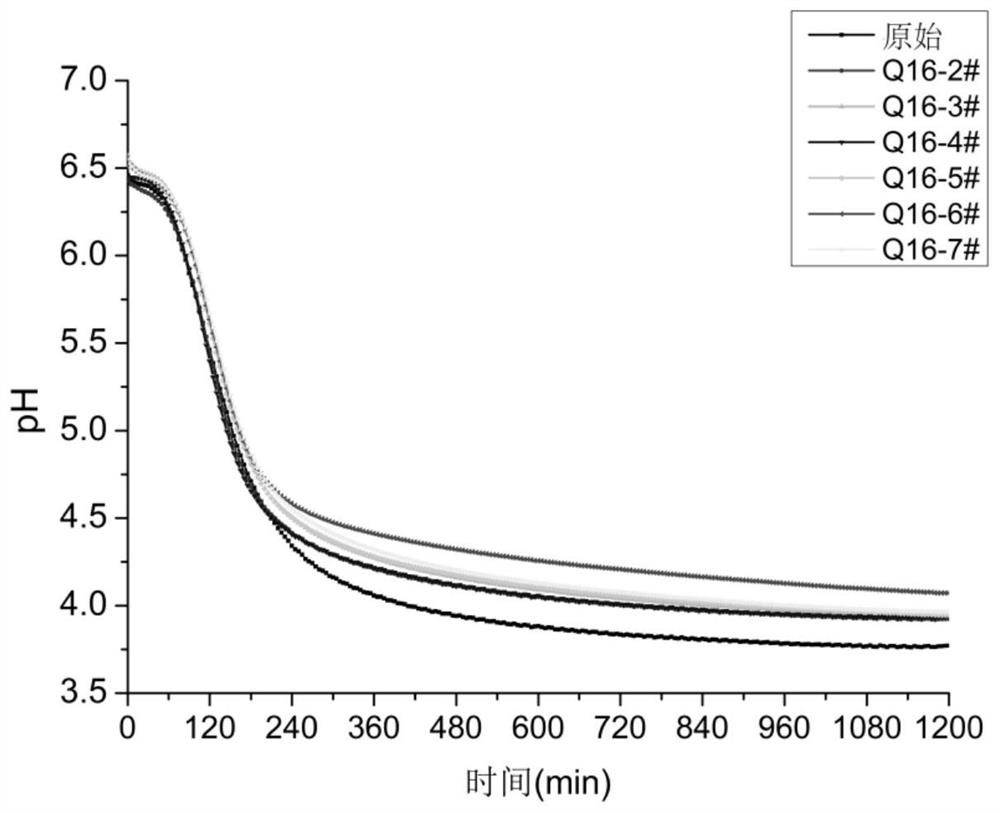Method for breeding weak post-acidification streptococcus thermophilus strain
A Streptococcus thermophilus, post-acidification technology, applied in microorganism-based methods, biochemical equipment and methods, treatment of microorganisms with electricity/wave energy, etc., can solve the problem of inability to efficiently breed weak post-acidification Streptococcus thermophilus strains problem, to achieve the effect of increasing the mutation frequency
- Summary
- Abstract
- Description
- Claims
- Application Information
AI Technical Summary
Problems solved by technology
Method used
Image
Examples
Embodiment 1
[0031] (1) Preparation of bacterial suspension: Pick a single colony (starting strain) and culture it in M17 medium at 37°C for 16 hours; transfer 3% of the inoculum to fresh M17, culture it at 42°C for 4 hours, centrifuge, wash twice, concentrate (2.67 times ) in an empty plate and set aside, the M17 medium includes the following components: soybean peptone 5g, yeast extract 5g, polypeptone 5g, ascorbic acid 0.5g, beef extract 2.5g, β-glycerophosphate disodium 19g, agar 15g, magnesium sulfate 0.5ml, distilled water 1L, pH 7.0, the magnesium sulfate is 1.0mol / L magnesium sulfate aqueous solution;
[0032] (2) Ultraviolet irradiation: preheat the ultraviolet mutagenesis instrument for 30 minutes in advance, and irradiate the suspension under ultraviolet light for 5 seconds (lethal rate is 95%);
[0033] (3) Rejuvenation culture: Resuspend the bacteria in fresh M17 medium and culture at 42°C until the pH drops to 4.4;
[0034] (4) Penicillin treatment: add 10ug / mL penicillin an...
Embodiment 2
[0057] (1) Preparation of bacterial suspension: Pick a single colony (starting strain) and incubate in M17 medium at 37°C for 12 hours; transfer 3% of the inoculum to fresh M17, incubate at 42°C for 5 hours, centrifuge, wash twice, concentrate (2.67 times ) in an empty plate for subsequent use. The M17 medium includes the following components: soybean peptone 6g, yeast extract 6g, polypeptone 6g, ascorbic acid 0.8g, beef extract 2g, β-glycerophosphate disodium 18g, agar 12g , magnesium sulfate 1ml, distilled water 1L, pH 7.0, described magnesium sulfate is 1.0mol / L magnesium sulfate aqueous solution;
[0058] (2) Ultraviolet irradiation: preheat the ultraviolet mutagenesis instrument for 30 minutes in advance, and irradiate the suspension under ultraviolet light for 5 seconds (lethal rate is 95%);
[0059] (3) Rejuvenation culture: Resuspend the bacteria in fresh M17 medium and culture at 42°C until the pH drops to 4.5;
[0060] (4) Penicillin treatment: add 10ug / mL penicilli...
Embodiment 3
[0069] (1) Preparation of bacterial suspension: Pick a single colony (starting strain) and culture it in M17 medium at 37°C for 18 hours; transfer 3% of the inoculum to fresh M17, culture it at 42°C for 4.5 hours, centrifuge, wash twice, concentrate (2.67 times) in an empty plate, standby, the M17 medium includes the following components: soybean peptone 5.5g, yeast extract 5.5g, polypeptone 5g, ascorbic acid 0.6g, beef extract 2.2g, β-glycerophosphate disodium 20g, agar 14g, magnesium sulfate 0.8ml, distilled water 1L, pH 7.1, the magnesium sulfate is 1.0mol / L magnesium sulfate aqueous solution;
[0070] (2) Ultraviolet irradiation: preheat the ultraviolet mutagenesis instrument for 30 minutes in advance, and irradiate the suspension under ultraviolet light for 5 seconds (lethal rate is 95%);
[0071] (3) Rejuvenation culture: Resuspend the bacteria in fresh M17 medium and culture at 42°C until the pH drops to 4.4;
[0072] (4) Penicillin treatment: add 8ug / mL penicillin at ...
PUM
 Login to View More
Login to View More Abstract
Description
Claims
Application Information
 Login to View More
Login to View More - R&D
- Intellectual Property
- Life Sciences
- Materials
- Tech Scout
- Unparalleled Data Quality
- Higher Quality Content
- 60% Fewer Hallucinations
Browse by: Latest US Patents, China's latest patents, Technical Efficacy Thesaurus, Application Domain, Technology Topic, Popular Technical Reports.
© 2025 PatSnap. All rights reserved.Legal|Privacy policy|Modern Slavery Act Transparency Statement|Sitemap|About US| Contact US: help@patsnap.com



